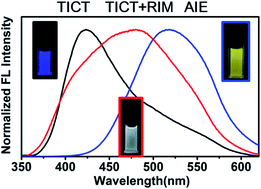Tuning the fluorescence based on the combination of TICT and AIE emission of a tetraphenylethylene with D–π–A structure†
Abstract
A simple D–π–A structured tetraphenylethylene with two electron-rich methyloxy groups and two electron withdrawing cyano groups, which features both twisted intramolecular charge-transfer (TICT) and aggregation-induced emission (AIE) properties, namely TPEOMeCN has been prepared. The emission of TPEOMeCN examined in various solvents is dependent on the polarities of solvents, which indicates the TICT character. The emission intensity of the compound also enhances with the increasing water fraction in H2O–DMSO mixtures, demonstrating the typical AIE property. Excitingly, the TICT and AIE emission could be observed separately or simultaneously by adjusting the water fraction or viscosity of the solvent. Encouragingly, the combined emission of the TPEOMeCN derived from this single molecule could be readily tuned via regulating the viscosity of the system, resulting in a broad emission peak which covers the visible spectrum (400–700 nm). This work provides a general strategy for designing molecules combining TICT emission and AIE for application as full-color emitters.



 Please wait while we load your content...
Please wait while we load your content...